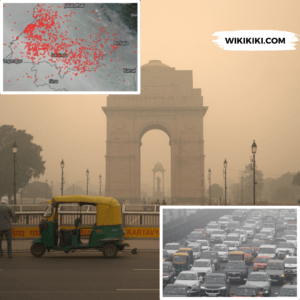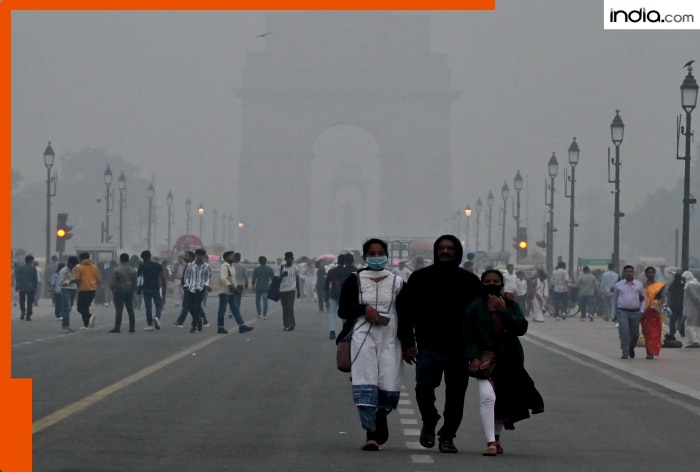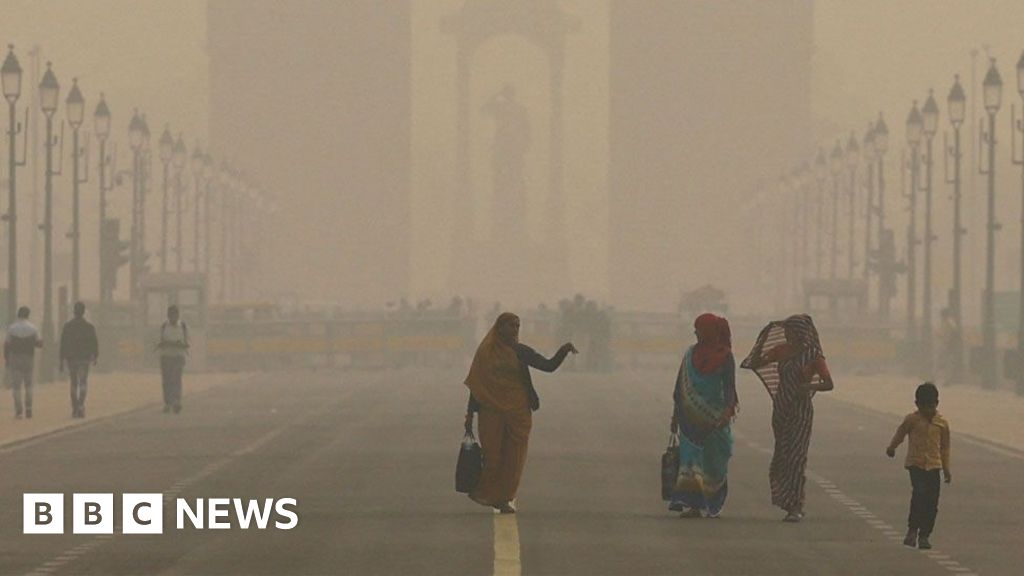According to the latest Delhi pollution news reports, On November 19, 2024, the National Capital Region experienced hazardous air quality with AQI levels reaching as high as 500. The Delhi government to set implement Stage IV of the Graded Response Action Plan. This includes transitioning schools to online classes and limiting public office attendance to 50%.

On November 19, 2024, several areas recorded AQI levels as high as 500 categorized as severe plus, the seventh consecutive day of hazardous air quality in the National Capital Region.
The Delhi government has enacted Stage IV of the Graded Response Action Plan. This includes shifting schools and universities to online classes, limiting public offices to 50% capacity and banning non-essential trucks from entering the city.
The University of Delhi will conduct online classes until November 23, while Jawaharlal Nehru University will do so until November 22.
Delhi’s Chief Minister Atishi criticizing neighboring states for stubble burning. The BJP has blamed the Aam Aadmi Party for failing to manage the crisis.
According to the latest Delhi pollution news reports, the India Meteorological Department has also issued an orange alert for dense fog.
The Union health secretary has issued a health advisory urging residents to stay indoors and wear masks if they must go outside. Reports show that residents are suffering from respiratory issues due to the toxic air.
On November 7, 2024, the Supreme Court directed these states to immediately stop crop residue burning. The court addressed the health risks posed by pollution and mandated local authorities to ensure compliance.
The Punjab government has proposed incentives for farmers to switch from paddy cultivation to alternative crops like millets. This includes offering a minimum support price to encourage this transition and reduce reliance on paddy.
The Indian government has established a scheme providing financial assistance for purchasing machinery to manage crop residues.
This includes subsidies covering up to 50% of the cost for individual farmers and 80% for cooperative societies and farmer organizations to set up Custom Hiring Centres for crop residue management equipment. Over the past few years, funds have been allocated to support this initiative.
States are encouraged to adopt both in-situ and ex-situ crop residue management practices. This includes educating farmers about environmentally friendly methods and promoting short-duration paddy varieties that produce less stubble.
The Supreme Court has made local officials responsible for preventing stubble burning incidents, holding them accountable if violations occur. This includes directives for local governments to monitor compliance actively.
According to the latest Delhi pollution news reports, Residents are experiencing increased respiratory problems including asthma and chronic obstructive pulmonary disease. Exposure to the hazardous air quality with AQI levels soaring above 500 and it is akin to smoking nearly 50 cigarettes daily.
Schools have transitioned to online classes for students up to class 12. This decision plans to protect children from exposure to harmful air quality. Institutions like Jawaharlal Nehru University have also opted for remote classes until conditions improve.
Many workplaces are encouraging employees to work from home or operate at reduced capacity. Public and private offices are mandated to function at only 50% capacity to minimize health risks associated with commuting and being indoors in polluted environments.
According to the latest Delhi pollution news reports, the government has implemented restrictions on vehicle use including bans on older diesel vehicles and trucks. Public transport is being promoted as an alternative. Additionally, visibility issues caused by smog have affected travel leading to delays in air and rail services.
Exposure to high levels of particulate matter (PM2.5) increases the risk of developing chronic respiratory conditions such as asthma, chronic obstructive pulmonary disease and lung cancer. The particulate matter can penetrate deep into the lungs and even enter the bloodstream.
There is a rise in cases of acute respiratory symptoms including pneumonia and exacerbations of existing conditions like asthma and COPD. Hospitals are reporting increased patient visits related to respiratory distress during periods of high pollution.
Exposure to air pollution is linked to risks of heart attacks, strokes and hypertension. Fine particulate matter can lead to inflammation and oxidative stress.
Research suggests that air pollution can affect cognitive functions leading to early cognitive decline, dementia and increased stroke risk particularly among older adults.
According to a report from the Energy Policy Institute at the University of Chicago, residents in Delhi could lose an average of 11.9 years of life expectancy due to high levels of PM2.5 pollution.
As of November 2024, the GRAP has escalated to Stage IV due to dangerously high AQI levels, which includes stringent measures such as banning the entry of non-essential trucks, restricting construction activities and limiting the use of diesel generator sets.
As winter approaches, the temperature drops leading to temperature inversions. This occurs when a layer of warm air traps cooler air near the surface.
The transition from the southwest monsoon to winter is characterized by reduced wind speeds. These calm conditions hinder the dispersion of pollutants allowing them to linger in the atmosphere.
Studies show that during this period, winds from regions like Punjab and Haryana carry particulate matter into Delhi.
Delhi Air Pollution Crisis (November 2024), As of Delhi Pollution News Reports
According to the latest Delhi pollution news reports, the air quality in Delhi has reached high levels with the Air Quality Index surpassing 450 in several areas categorizing it as severe plus. This situation is driven by extremely high levels of PM2.5, which have been recorded at over 300 µg/m³ more than 20 times higher than the World Health Organization’s safe limit.
Specific locations have recorded even higher values such as 919 in Mundka, 762 in Jahangirpuri and 624 in Anand Vihar.
An AQI above 400 is classified as severe, while values exceeding 450 fall into the severe plus category. Under these conditions, the air quality poses serious health risks to everyone.
The Central Pollution Control Board has indicated that such levels of pollution can lead to respiratory issues and other health complications.
In Anand Vihar, the AQI has reached 490, categorizing it as severe. This area is impacted by various pollutants primarily particulate matter (PM2.5) and PM10.
According to the latest Delhi pollution news reports, Jahangirpuri records an AQI of 480, also falling into the severe category. Both locations are among the worst affected in the city due to a combination of factors including stubble burning and unfavorable meteorological conditions that trap pollutants close to the ground.
Lutyens’ Delhi shows a relatively better air quality with an AQI around 350, which still falls under the very poor category.
Delhi’s air quality in November 2023 has shown a 10% increase in the Air Quality Index compared to the same month last year. The average AQI for November 2023 is projected to be around 372 compared to 377 in November 2022.
A major factor influencing this spike in pollution levels is stubble burning, which has been identified as contributing approximately 40% of the PM2.5 load during peak pollution days.
The Central Pollution Control Board reported that on certain days, the AQI reached high levels with readings as high as 494 and even hitting 500 in some areas.
The combination of local emissions, stubble burning from neighboring states and unfavorable weather conditions has led to an increase in PM2.5 concentrations, which have been recorded at levels above World Health Organization standards.
PM2.5 levels were reported at 354 micrograms per cubic meter, over twenty times higher than the recommended limit.
According to the latest Delhi pollution news reports, Hospitals in Delhi are receiving over 1,000 daily complaints related to breathlessness and eye irritation. This surge is attributed to the severe air quality conditions that have persisted since Diwali.
The most affected groups include the elderly and children. Many patients are experiencing coughing, chest congestion and other symptoms indicative of chronic respiratory conditions.
Facilities like Ram Manohar Lohia Hospital have established specialized outpatient departments for pollution-related health issues. These OPDs have seen an increase in patient visits.
Doctors report that many patients previously managing mild respiratory conditions are now requiring more intensive treatments including bronchodilators and steroids.
Delhi is facing a severe air pollution crisis with transport accounting for approximately 30% of PM2.5 emissions in the region. The situation is exacerbated by the addition of around 1,500 new vehicles daily.
A huge portion of emissions comes from older diesel vehicles, which are known to release higher amounts of harmful pollutants.
The Delhi government has implemented bans on BS-III petrol and BS-IV diesel vehicles to tackle this issue particularly as these older models are often exempt from stricter regulations.
Under GRAP Stage 4, the movement of non-compliant vehicles is heavily restricted. Violators face penalties including fines of up to ₹20,000 for operating banned vehicles.
Recent satellite data shows an increase in agricultural fires with approximately 70,000 active farm fires reported in Punjab and Haryana over the past month.
According to the latest Delhi pollution news reports, Crop residue burning has been estimated to contribute between 15.8% to 29.9% of total carbon monoxide emissions in the National Capital Region during the burning period with Punjab accounting for about 75% of these emissions.
However, other sources such as vehicular emissions and industrial activities are also contributors with transport alone accounting for around 55.4% of carbon monoxide emissions in Delhi.
Data from the Indian Institute of Tropical Meteorology suggests that stubble burning contributed only about 1.3% to Delhi’s air pollution on October 19, 2024.
A study published in The Lancet highlighted that Delhi experienced the highest per-capita economic loss due to air pollution in India amounting to 1.08% of its GDP.
The rising medical expenses associated with treating pollution-related diseases strain the economy. Estimates suggest that the treatment costs for air pollution-related ailments account for about 0.4% of India’s GDP.
Over 50% of Delhi’s air pollution during winter is attributed to local sources primarily vehicular emissions. The city’s fragmented transportation system exacerbates this issue with an estimated 1.1 million vehicles entering and exiting daily.
According to the latest Delhi pollution news reports, Traffic congestion has a direct financial impact on workers with unskilled laborers losing between ₹7,500 and ₹20,100 annually due to delays, while skilled workers face losses of ₹9,900 to ₹26,600.
Delhi has been reported as one of the top 10 most polluted cities globally, according to IQAir’s 2024 report. This ranking shows the air quality challenges faced by the city.
Beijing’s annual average PM2.5 concentration dropped by 35% from 2013 to 2017. The municipal government invested heavily in pollution control, increasing its budget from approximately 3 billion yuan in 2013 to over 18 billion yuan by 2017.
Top Sources Related to Delhi Pollution News: Delhi Air Quality Reaches Severe Category – November 2024 (For R&D)
Live Mint:
Also Read: Latest Mpox News, Vaccination Updates and More – November 2024




















